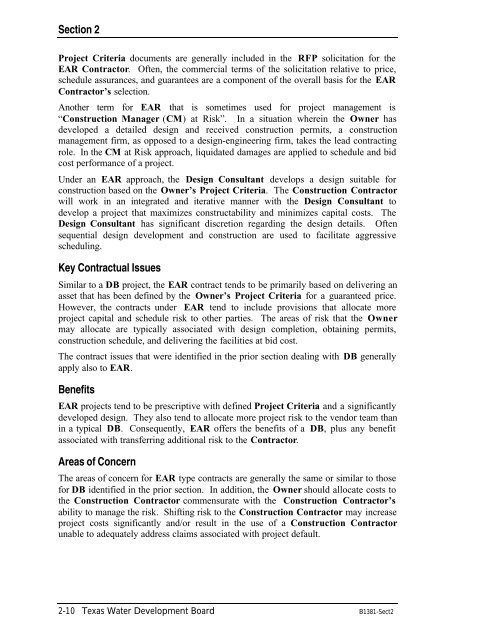Alternative Project Delivery - Texas Water Development Board
Alternative Project Delivery - Texas Water Development Board
Alternative Project Delivery - Texas Water Development Board
Create successful ePaper yourself
Turn your PDF publications into a flip-book with our unique Google optimized e-Paper software.
Section 2<br />
<strong>Project</strong> Criteria documents are generally included in the RFP solicitation for the<br />
EAR Contractor. Often, the commercial terms of the solicitation relative to price,<br />
schedule assurances, and guarantees are a component of the overall basis for the EAR<br />
Contractor’s selection.<br />
Another term for EAR that is sometimes used for project management is<br />
“Construction Manager (CM) at Risk”. In a situation wherein the Owner has<br />
developed a detailed design and received construction permits, a construction<br />
management firm, as opposed to a design-engineering firm, takes the lead contracting<br />
role. In the CM at Risk approach, liquidated damages are applied to schedule and bid<br />
cost performance of a project.<br />
Under an EAR approach, the Design Consultant develops a design suitable for<br />
construction based on the Owner’s <strong>Project</strong> Criteria. The Construction Contractor<br />
will work in an integrated and iterative manner with the Design Consultant to<br />
develop a project that maximizes constructability and minimizes capital costs. The<br />
Design Consultant has significant discretion regarding the design details. Often<br />
sequential design development and construction are used to facilitate aggressive<br />
scheduling.<br />
Key Contractual Issues<br />
Similar to a DB project, the EAR contract tends to be primarily based on delivering an<br />
asset that has been defined by the Owner’s <strong>Project</strong> Criteria for a guaranteed price.<br />
However, the contracts under EAR tend to include provisions that allocate more<br />
project capital and schedule risk to other parties. The areas of risk that the Owner<br />
may allocate are typically associated with design completion, obtaining permits,<br />
construction schedule, and delivering the facilities at bid cost.<br />
The contract issues that were identified in the prior section dealing with DB generally<br />
apply also to EAR.<br />
Benefits<br />
EAR projects tend to be prescriptive with defined <strong>Project</strong> Criteria and a significantly<br />
developed design. They also tend to allocate more project risk to the vendor team than<br />
in a typical DB. Consequently, EAR offers the benefits of a DB, plus any benefit<br />
associated with transferring additional risk to the Contractor.<br />
Areas of Concern<br />
The areas of concern for EAR type contracts are generally the same or similar to those<br />
for DB identified in the prior section. In addition, the Owner should allocate costs to<br />
the Construction Contractor commensurate with the Construction Contractor’s<br />
ability to manage the risk. Shifting risk to the Construction Contractor may increase<br />
project costs significantly and/or result in the use of a Construction Contractor<br />
unable to adequately address claims associated with project default.<br />
2-10 <strong>Texas</strong> <strong>Water</strong> <strong>Development</strong> <strong>Board</strong> B1381-Sect2
















